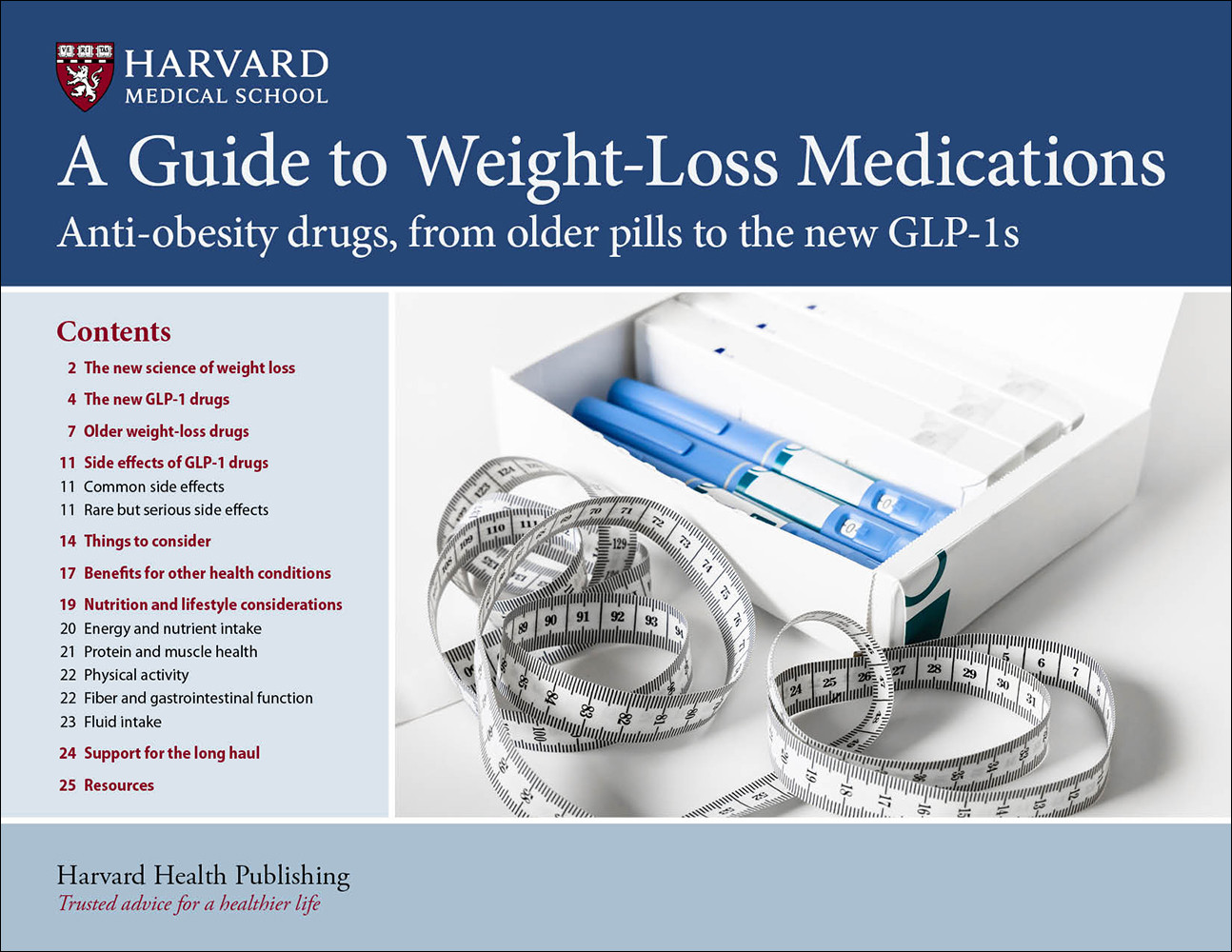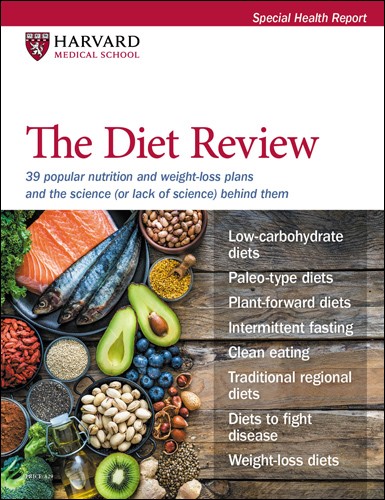
5 timeless habits for better health

What are the symptoms of prostate cancer?

Is your breakfast cereal healthy?

When pain signals an emergency: Symptoms you should never ignore

Does exercise give you energy?

Acupuncture for pain relief: How it works and what to expect

How to avoid jet lag: Tips for staying alert when you travel

Biofeedback therapy: How it works and how it can help relieve pain

Best vitamins and minerals for energy

Should you take probiotics with antibiotics?


Weight Loss Drugs: Anti-obesity drugs, from older pills to the new GLP-1s
Losing weight is hard to do. For some people diet and exercise alone may not be enough. Anti-obesity, or weight loss drugs can help. From endless ads for medications like Ozempic or Wegovy to news stories of successful weight loss, almost everyone is aware of the newest weight loss medications, GLP-1s.
But how do they work? Are they safe? And most importantly… who is most likely to benefit from them?
A Guide to Weight-Loss Medications covers the science, risks, potential side effects, pros, and cons of this medication-assisted weight loss. This guide is your trusted resource to help you have informed conversations with your doctor about weight and metabolic health.
In this easy-to-understand guide, you’ll learn:
• The medical science behind the three major classes of anti-obesity drugs. Is one a good choice for you?
• How the GLP-1 drugs work in your body to decrease appetite, lower blood sugar, trick your brain and your gut into feeling fuller faster, and more, as well as some other unexpected health benefits
• Understanding “older” weight loss medications
• How to recognize and manage common side effects
• Practical advice to help you succeed in long term weight management
A Guide to Weight-Loss Medications also gives you critical information such as:
• The danger zone of Body Mass Index. How to know if you’re in the high-risk BMI zone
• What drug is best if you suffer from genetic obesity. Ask your doctor for these genetic tests
• Potential rare and serious side effects of GLP-1, and when to seek medical help urgently
• How to identify GLP-1 scams
• Who shouldn’t take GLP-1 drugs
• When to consider weight-loss surgery
If you are struggling to reach a healthy weight, this report can help you understand how weight-loss drugs work… and if they might be appropriate medical treatment for you, order your copy of A Guide to Weight-Loss Medications from the experts at Harvard Medical School today.
Other Product Information
If you’ve been overwhelmed by the number of weight-loss medications now available and wonder if these drugs might help you, you’ll want to get your hands on this new Special Health Report from the experts at Harvard Medical School.
A Guide to Weight-Loss Medications goes beyond the headlines and onslaught of ads to truthfully explain in plain, understandable language how weight-loss medications, including GLP-1 drugs, such as Ozempic, Wegovy, Mounjaro, and Zepbound, could work for you to finally lose weight and keep it off.
This report explains each medication in detail. You’ll learn:
• how each medication works in your body
• the potential side effects and how to manage them
• how much weight loss you can expect
• compounded formulations, and how to avoid counterfeit versions
• who should avoid taking weight-loss drugs
• and so much more.
Prepared by the editors of Harvard Health Publishing in consultation with Chika V. Anekwe, MD, MPH, PNS, Instructor in Medicine, Harvard Medical School, Obesity Medicine Clinical Director, Massachusetts General Hospital. 25 Pages. (2025)
About Harvard Medical School Guides
Harvard Medical School Guides delivers compact, practical information on important health concerns. These publications are smaller in scope than our Special Health Reports, but they are written in the same clear, easy-to-understand language, and they provide the authoritative health advice you expect from Harvard Health Publishing.
How GLP-1 drugs work
Agonists are substances that mimic the actions of certain chemicals in the body—neurotransmitters or hormones—to produce a response upon binding to a specific receptor on a cell. GLP-1 receptor agonist medications mimic the action of glucagon-like peptide 1 (GLP-1), a hormone secreted by your intestines when you eat. GLP-1 and its agonists bind to receptors in the pancreas, activating them to secrete insulin after you eat. Insulin is an essential hormone that moves glucose (sugar) out of your blood and into your cells, where your body can use it for energy. GLP-1 also prevents more glucose from going into your bloodstream by blocking secretion of glucagon, a hormone your body uses to raise your blood sugar levels when necessary. This is why GLP-1 receptor agonists were first used to help treat diabetes.
But GLP-1 and its agonists also activate GLP-1 receptors in the gut and brain that cause you to feel hungry before eating and no longer hungry (sated) after eating. The effects last much longer than those of the GLP-1 produced by your body. These drugs reduce appetite by making you feel full more quickly, so food is less rewarding. They also slow stomach emptying, so you feel full longer. (See Figure 1, page 5.) These combined effects often result in weight loss. In addition to boosting GLP-1, the GLP-1/GIP agonist tirzepatide (Zepbound) mimics the hormone gastric inhibitory polypeptide (GIP), which has similar effects to those of GLP-1.
Weight loss on these drugs can be significant. In clinical trials, which compared people randomly assigned to the active drug or a placebo, participants receiving semaglutide or tirzepatide lost 15% to 20% of their body weight on average. That approaches what people can lose with weight-loss surgery. People in the trials who got placebo injections lost much less weight, about 2.4% to 3.4%. All participants were advised to follow a program of diet and exercise. The higher the dose of the GLP-1 agonist, the greater its effects.
Unlike older weight-loss medications, which are taken as pills, GLP-1 drugs are self-administered via daily or weekly subcutaneous (under the skin) injections using a pre-filled pen. Common injection sites are the stomach, upper leg, or upper arm. They are not injected into a vein or muscle. Liraglutide and semaglutide are the only two of these drugs approved for children ages 12 and older.
- The new science of weight loss drugs
- The new GLP-1 drugs
- Older weight-loss drugs
- Side effects of GLP-1 drugs
- Common side effects
- Rare but serious side effects
- Things to consider
- Benefits for other health conditions
- Nutrition and lifestyle considerations
- Energy and nutrient intake
- Protein and muscle health
- Physical activity
- Fiber and gastrointestinal function
- Fluid intake
- Support for the long haul
- Resources
You might also be interested in…

The Diet Review: 39 popular nutrition and weight-loss plans and the science (or lack of science) behind them
You have tremendous latitude in what goes into your daily diet—and the choices you make can have profound consequences for your health. But what diet should you choose? The range is truly dizzying. Just some of the diets you might encounter are vegan, pegan, and portfolio. Raw food, whole foods, and Whole 30. Keto, carnivore, and paleo. Clean eating and intermittent fasting. DASH, MIND, and Volumetrics. Mediterranean, Nordic, and Okinawan. What does it all mean? And how can you begin to make sense of it? This Special Health Report is here to help.

5 timeless habits for better health

What are the symptoms of prostate cancer?

Is your breakfast cereal healthy?

When pain signals an emergency: Symptoms you should never ignore

Does exercise give you energy?

Acupuncture for pain relief: How it works and what to expect

How to avoid jet lag: Tips for staying alert when you travel

Biofeedback therapy: How it works and how it can help relieve pain

Best vitamins and minerals for energy

Should you take probiotics with antibiotics?
Free Healthbeat Signup
Get the latest in health news delivered to your inbox!
Sign Up